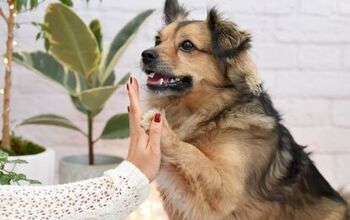How to Train Your Pet to Be a Visiting Therapy Dog

So, you think your gentle, people-loving pooch would be a great fit as a nursing home Therapy dog? Let’s start by saying congratulations on exploring this option. Pet visitation programs have become popular across the globe because of their proven ability to enhance the quality of life and help improve the health of seniors including those suffering from depression, dementia and Alzheimer’s disease.
And while you may be right about your little buddy being an ideal candidate for this type of work, there’s more to it than simply a winning disposition and disarming grin.
Breeds that Qualify
Wonder which breeds qualify? The short answer is that all breeds qualify however due to potential liability issues, each dog requires a certain level of certification before he gets to share the love. And because what this certification actually looks like can vary from state to state, province to province and even between the various retirement communities, you’ll want to start with the basic accreditations.
Let’s Get Started
The American Kennel Club (AKC) and the Canadian Kennel Club (CKC) offer behavioral certifications called the Canine Good Citizen (AKC) and the Canine Good Neighbor (CKC). Both programs include a series of tests that your pooch must perform and pass in front of a live evaluator.
Each club’s testing system requires among other things, that your dog to be friendly with strangers, that he come when called, sit and stay on command, be receptive to patting and have a clean, well-groomed appearance.
The Tests
The requirements below, are pulled from both the AKC and CKC testing requirements. For each objective, we share training tips on how to get your pooch up to speed and ready for his final evaluation. That evaluation takes no more than 10 to 15 minutes and is conducted by accredited, dog-friendly folk who are located throughout North America and are both supportive and rooting for your best buddy to claim his title.
1. Willing to accept the approach of a friendly stranger reaching out to shake hands with you.
Socialization is key here and if your pet wasn’t introduced to new sights, sounds, and faces when he was a fearless little pup, he’ll likely feel anxious when taken out of his comfort zone as an adult. Your goal is to build his confidence and lessen his fears by providing him with gradual, controlled exposure to new situations. Plan to:
· Bring him to a dog park and remain within sight in case he feels crowded or overwhelmed by other dogs.
· Introduce him to new faces – both adults and children. Progress can be measured in his reaction to these new situations. Is he comfortable when strangers approach – meaning he doesn’t growl, bark, lunge, or hide behind you?
· As he progresses, consider dropping him at a doggie daycare center from time to time. This allows him to mix with new faces in a supervised situation where you’re not present. And staff are great at sharing report cards on just how well your dog integrated with others and if there were any hot buttons.
2. Sit politely and accept being patted over a period of time without shying away or showing wariness.
Meeting this requirement relies heavily on how well socialized your dog is. If he’s passed the meet and greet phase with flying colors, it’s time to introduce him to the sensation of being patted and touched by strangers. Start with people you know but who your dog may not be as familiar with. He should be able to sit, stay and accept the pat without mouthing, pulling back or feeling threatened (treats help keep your pooch on point).
This needs to happen in a controlled manner, one person at a time, and with them instantly withdrawing if your pet becomes anxious. His comfort level with being touched and cuddled by strangers will grow with continued exposure. It’s not a process you can rush and is a step that is critically important to how well he will perform as a therapy dog.
3. Be responsive when taken for a short walk including completing, left, right and about-turns as well as stopping.
One of the five basic commands, “heel” can be a tricky one to master when your dog is excitedly tugging and pulling in an effort to get the walk started. Because this is an important discipline for a Therapy dog, clicker training might be the way to go. And it’s a fairly simple process. Call your dog to come to you as you start to walk (the standard heel position is on your left side). When he arrives, say “good boy/girl” while at the same time clicking the clicker and offering up that all-important treat.
Practice this a few times until your pet has the hang of it. Then eliminate the verbal command and simply use the clicker to draw your dog over to you and into position. Once the task has been completed successfully, mix it up by changing your pace or direction to require your dog to regain his heel position and adapt his stride.
4. Be comfortable moving through a crowd of strangers without jumping up.
Here’s another requirement that relies on your pet being fully socialized and capable of interacting with strangers, minus fear, aggression, or over-exuberance. And it’s an important skill for Therapy dogs who may need to move through crowded nursing homes or hospitals while remaining calm and focused. Start with taking him on short, leashed walks of no more than five to 10 minutes through a crowd where he can still see ahead and to the sides. Offer plenty of verbal praise (with treats) as he remains focused on the walk and non-reactive to the outside stimulation.
Over time, your pet will change his association with crowds and strangers from a fearful experience to one loaded with encouragement and treats. Gradually extend the length of your walks to help reinforce the positive/non-threatening nature of these situations.
5. Sit and stay on command, then remain in the stay position when you walk away before returning.
The American Kennel Club emphasizes the need for a start and finish to the Stay command. Choose a word to be used exclusively to release your pet from the Stay position. It could be “over” or “OK” or “free” - you pick. Now, because it should be strictly for releasing your pet from his Stay, avoid choosing his name, “come”, or any other command word that might confuse when used later.
When your pet has assumed a Sit or Down position, use the Stay command. Within a few seconds, use the release word and issue a treat. If he remains in his Stay position, encourage him to get up and come toward you.
6. Sit, stay, and then come when called from a 30-foot distance.
Once the Stay/Release command is mastered you’re ready to move on to the three Ds: Duration, Distance and Distractions.
Duration is how long your dog remains in a stay position, Distance is how far you move away from your pet, and Distractions are all that stuff that can happen around him while he’s patiently waiting in the Stay position. All can be trained and controlled.
· To build on Duration, issue the Stay command, count to three, then issue the release word with a treat. Repeat the process, increasing each interval by a few seconds. If he releases early, repeat the Sit/Stay commands and begin again.
· Distance training takes longer and requires a little more patience. Deliver the Sit/Stay commands, then take one step back from your dog while he remains in the Stay position. Pause, then step back toward him and deliver the treat if he’s remained in place. Next, take two steps back, then forward to your dog. Repeat the process, adding an extra step each time.
· It’s important to have mastered the Distance and Duration commands before adding Distractions. Noise, a squirrel, anything can draw your dog’s attention away from the task at hand. To de-sensitize your pet, add small distractions in a controlled environment such as your backyard. Increase the number and level of distractions, then move to a different environment and repeat. And up the game as it relates to treats. AKC recommends “higher value” options for this one.
Want a handy training tip? Always hold treats up at chest level to prevent luring (dog just following the food versus the command).
When your training is complete and your pet has received his Canine Good Citizen or Canine Good Neighbor certification, you’ll want to align yourself with an established Therapy dog program that can identify those facilities that are in need of this service. In the United States, the AKC website has a list of Therapy dog organizations including the Alliance of Therapy Dogs and Therapy Dogs International. In Canada, organizations such as St. John’s Ambulance are good places to start once you feel your dog is ready to start spreading the love.

Sharing space with three seriously judgy Schnoodles and a feline who prefers to be left alone. #LivingMyBestLife
More by Mary Simpson























